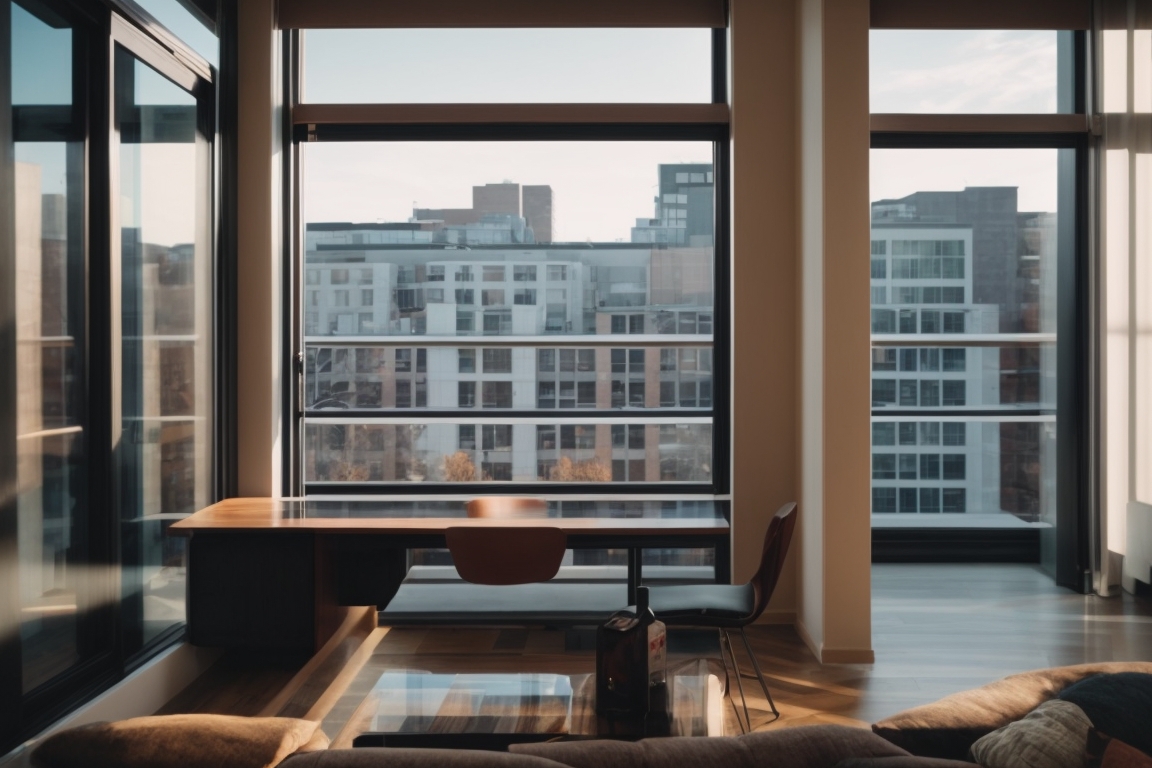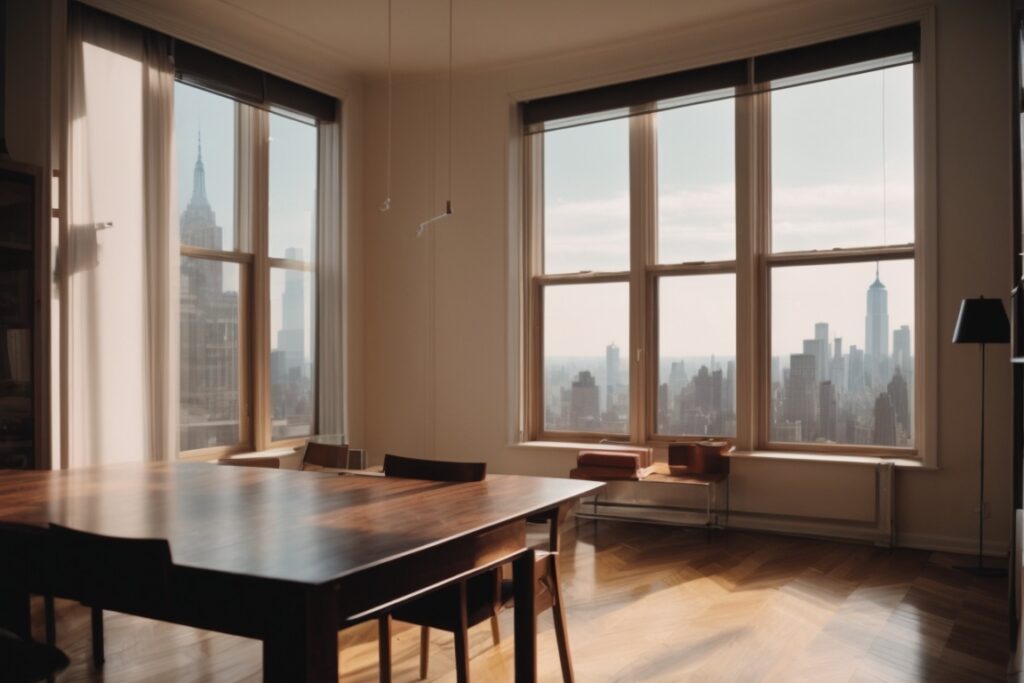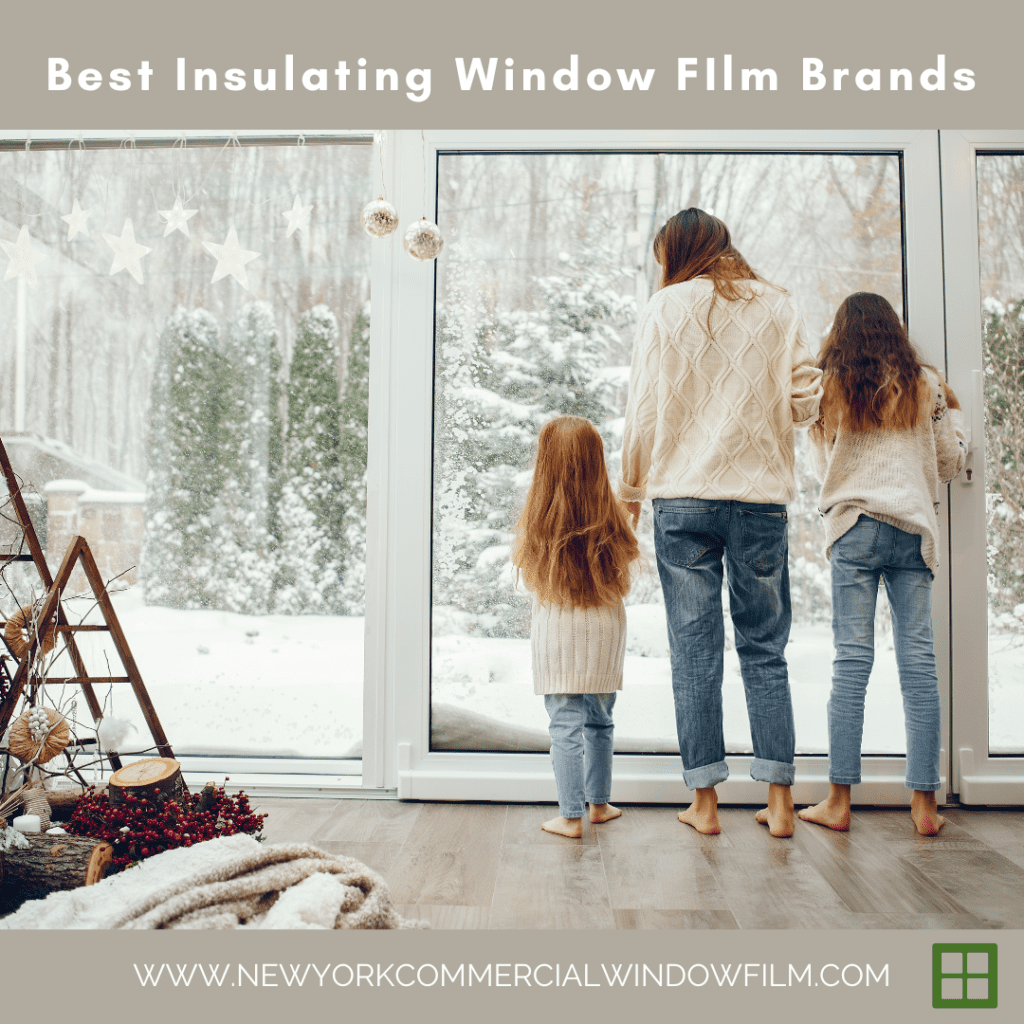The Glare and Energy Enigma of New York’s Glass Facades
In the bustling urban landscape of New York, a city renowned for its iconic glass glide architecture, a pressing issue is casting a shadow over the luminous exteriors of its skyscrapers and residential buildings. This problem is not rooted in the structural integrity or the architectural prowess of these glass marvels but lies in the very material that gives them their sleek, modern look. The heart of the matter is the excessive glare and the soaring energy consumption attributed to the standard glass used in many of New York’s buildings, a problem that calls for the innovative solution of low-e glass film.
The allure of glass buildings lies in their ability to blend indoor and outdoor spaces seamlessly, providing breathtaking views of the city’s skyline while fostering a modern, open-concept aesthetic. However, this architectural choice comes with its drawbacks. The extensive use of conventional glass in buildings contributes significantly to high levels of solar heat gain, leading to increased reliance on air conditioning systems during the warmer months. This not only exacerbates the urban heat island effect but also results in hefty energy bills for property owners.
Moreover, the issue of glare is more than just a mere inconvenience for the occupants. It poses challenges to both the comfort and productivity of individuals working or living within these glass structures, impacting their daily lives. The combination of excessive heat and glare creates an environment that, while visually striking, is not always conducive to the well-being of its occupants.
In essence, the problem New York faces with its glass glide architecture isn’t just about maintaining the aesthetic appeal or structural integrity of its buildings. It’s about finding a balance between form and function, ensuring that these glass marvels can provide comfort and sustainability in equal measure. This highlights a need for innovative solutions like low-e glass film, which can address the inherent weaknesses of traditional glass, paving the way for a more energy-efficient and comfortable urban habitat.
Understanding the Roots of the Glass Dilemma
New York’s architectural marvels are characterized by their awe-inspiring glass structures, a testament to the city’s innovative spirit. However, this comes with its unique set of challenges, particularly when it comes to energy efficiency. At the heart of this issue lies the widespread use of traditional glass in building construction, which, while adding to the aesthetic appeal, has significant downfalls in energy performance.
Traditional glass, unfortunately, is a poor insulator. During the winter months, heat easily escapes buildings, necessitating increased heating to maintain comfortable indoor temperatures. Conversely, in the sweltering New York summers, these buildings absorb a substantial amount of heat, leading to escalated cooling needs. This cycle of heating and cooling is not only energy-intensive but also contributes to the urban heat island effect, worsening the city’s air quality and overall climate. The problem is intrinsic to the material properties of standard glass, highlighting a pressing need for solutions that can reconcile New York’s architectural aspirations with its environmental responsibilities.
Feeling the Heat: The Unseen Dangers of Skimping on Low-E Glass Film in New York Homes
Opting out of installing Low-E glass film in New York’s distinctive Glass Glide architecture could severely diminish the comfort and energy efficiency of your living spaces. New York, known for its varied climate, demands adaptive solutions for home comfort and energy saving. Without the protective layer that Low-E glass film provides, residents may experience significant heat loss during winter and excessive solar heat gain in summer. This not only leads to uncomfortable living conditions but also escalates energy bills. The absence of Low-E glass film translates to a direct impact on your wallet and overall well-being, making it an issue that extends beyond mere aesthetic considerations of glass architecture.
The Escalating Cost of Inaction Against Low-E Glass Film Absence
In the bustling streets of New York City, amidst its towering glass-clad structures, a lurking issue promises to tighten its grip on the wallets and well-being of its inhabitants. The absence of Low-E glass film is more than just a minute detail in the grand tapestry of urban living—it’s a rapidly growing concern with ramifications that extend into the personal lives of every New Yorker.
Consider for a moment the relentless rise in utility bills, a consequence directly tied to inefficient energy consumption. Windows without Low-E glass film allow for the unchecked transfer of heat, demanding more from heating and cooling systems, thus inflating energy costs. But the financial strain doesn’t stop at surging utility bills. Imagine the discomfort of living or working in spaces that can’t keep the harsh summer heat or biting winter chill at bay. This constant battle against the elements not only affects your pocket but also your productivity and comfort.
The implications extend further into the health sphere. The absence of Low-E glass film means increased exposure to harmful UV rays, known precursors to ailments such as skin cancer and premature aging. Moreover, the excessive heat gain can compromise indoor air quality, exacerbating respiratory issues and contributing to a less than ideal living environment.
Perhaps more gravely, the ongoing negligence towards adopting Low-E glass film technologies silently depreciates property values, rendering New York’s iconic skyline, piece by piece, less appealing to prospective buyers and renters. Every window without Low-E glass film is a missed opportunity to elevate the standard of living, a step backward in the march towards sustainability and efficiency.
In a city that prides itself on leading the charge in innovation and quality of life, the omission of Low-E glass film stands as a glaring oversight. An oversight that, with each passing day, digs deeper into the finances and well-being of its citizens.
Highlighting the Urgency: The Critical Importance of Low-E Glass Film in New York’s Climate
New York’s distinctive seasons, ranging from scorching summers to frigid winters, make the installation of low-E glass film not just an aesthetic choice but a pressing necessity for energy efficiency and comfort. The city’s iconic skyscrapers and residential buildings alike face the constant challenge of temperature regulation, directly affecting the well-being of its inhabitants and operational costs.
Without the prompt incorporation of low-E glass film, New Yorkers could see a significant impact on their energy bills, not to mention the potential discomfort during extreme weather conditions. The urgency to act is further heightened by the ongoing push towards sustainability and reducing carbon footprints. Delaying the application of low-E glass film means missing out on immediate benefits in thermal insulation, leading to increased energy consumption and higher costs over time.
The window of opportunity to make a significant impact on both personal and environmental levels is now. With the rising awareness and regulations around energy conservation, the importance of updating to low-E glass film in New York’s buildings cannot be overstated. Procrastination in this matter not only leads to continued inefficiency but also foregoes the quick wins in comfort, cost-saving, and contributing to a more sustainable future.
Shield Your New York Abode with Low-E Glass Film
The bustling streets and towering skyscrapers of New York are not just a testament to human ingenuity but also to the relentless pursuit of comfort and sustainability in urban living. However, this quest is often challenged by the city’s extreme temperatures, from sweltering summers to frigid winters, leading to uncomfortable living spaces and skyrocketing energy bills. By integrating Low-E glass film into your home or office, you’re not merely choosing an upgrade; you’re making a smart, logical decision towards energy efficiency and comfort. This innovative solution significantly reduces energy consumption by minimizing heat transfer, thereby ensuring your space remains at a pleasant temperature year-round. It’s a thoughtful investment towards a sustainable, comfortable, and cost-effective living environment in the heart of New York.
Low-E Glass Film: Revolutionizing New York’s Urban Panorama
For those navigating the complexity of urban living in New York, the introduction of Low-E glass film is not just an innovation—it’s the solution that has long been awaited. This advanced film technology is transforming New York’s Glass Glide Architecture, bringing a new level of comfort, efficiency, and aesthetic appeal to both residential and commercial spaces.
Low-E glass film stands as an emblem of urban progress, offering a unique blend of energy conservation and heat management. By applying this film to your property, you’re not just upgrading your windows; you’re embarking on a journey towards environmental stewardship and significantly reduced energy costs. The benefits of this technology extend beyond the pragmatic—Low-E glass film enhances the natural lighting of your space while protecting interiors from UV damage, preserving the integrity and color of your furnishings.
In the bustling heart of New York, where the skyline is constantly challenged by the demands of modern living, Low-E glass film emerges as the definitive solution. It promises an improved living condition that aligns with the city’s sustainability goals. Imagine a home or office that stays cooler in the scorching summers and warmer during the biting winters—all while keeping energy consumption to a minimum. This is the promise of Low-E glass film; a promise of a future where architectural beauty and environmental consciousness go hand in hand.
As the city marches towards a greener tomorrow, make the strategic decision to embrace Low-E glass film. This isn’t just an investment in your property; it’s a commitment to a lifestyle that values efficiency, comfort, and the greater good of New York’s urban environment. Join the ranks of those leading the charge in redefining urban living. With Low-E glass film, the future of New York’s architecture not only looks brighter but also significantly smarter and more sustainable.
Transforming New York’s Skylines with Low-E Glass Film
The architectural beauty of New York is undeniable, with glass structures that touch the skies and reflect the city’s dynamic energy. However, the very essence of what makes these buildings stunning, their extensive glass facades, also poses significant environmental and energy efficiency challenges. Enter Low-E glass film, a game-changer in addressing these challenges, significantly impacting New York’s iconic glass glide architecture.
Low-E, or low-emissivity glass film, acts as an invisible barrier that reduces the amount of ultraviolet and infrared light that can pass through the glass without compromising the amount of natural daylight entering the building. This innovative solution offers a dual benefit – it substantially reduces the energy costs associated with heating and cooling these massive structures while also protecting the interiors from the harmful effects of sun exposure. In a city where the skyline is progressively evolving, Low-E glass film becomes not just an option but a necessity for sustainable development.
Moreover, the aesthetic integrity of architectural designs is preserved with Low-E glass film. It allows for the seamless integration of this technology without altering the visual appeal of buildings. This is particularly crucial in a place like New York, where architecture plays a pivotal role in the city’s character. Thus, Low-E glass film stands out as a viable solution for New York’s future, ensuring that the city’s glass structures remain both beautiful and sustainable.
Unexpected Perks of Low-E Glass Film
While the primary function of Low-E glass film in New York’s iconic Glass Glide architecture is to reduce heat loss and gain, its benefits surprisingly extend into spheres beyond thermal efficiency. Apart from contributing to a more comfortable indoor climate, Low-E glass film also offers substantial UV protection. This means that artworks, fabrics, and furniture within New York homes and buildings are less likely to fade over time, preserving the aesthetic and value of interior spaces. Moreover, the application of Low-E glass film enhances privacy during the daytime without sacrificing natural light, ensuring spaces remain bright yet secluded. These extra advantages make Low-E glass film not only a smart choice for energy conservation but also a guardian of home interiors and a provider of increased privacy.
Smart Living in the Empire State: Why Low-E Glass Film is the Future
In the heart of New York, where the skyline is as dynamic as its weather, the architectural marvel known as Glass Glide Architecture offers both challenges and opportunities. The city, known for its extremes – from blistering summers to bone-chilling winters – has been the playground for innovations aimed at enhancing living and working environments. Among these innovations, low-e glass film stands out as a beacon of intelligent design and foresight.
For New Yorkers, the quest to find balance between enjoying the panoramic vistas provided by glass structures and maintaining energy efficiency has been ongoing. The introduction of low-e glass film into this equation is not just an upgrade; it’s a leap into a future where comfort, sustainability, and cost-effectiveness align. This technological advance addresses the perennial problem of energy loss, providing a shield that reflects heat back into the room during winter and keeps the interior cool by reflecting UV rays out during summer.
Incorporating low-e glass film into the iconic Glass Glide Architecture signifies more than just adapting to New York’s climatic gyrations. It speaks to an ethos of proactive living—where New Yorkers are not just reacting to weather-related discomforts but are preemptively equipping their spaces with solutions that stand the test of time and temperature. It silently narrates a story of residents and businesses that value innovation, efficiency, and environmental stewardship.
The move towards integrating low-e glass film in new and existing buildings across New York isn’t merely a trend. It’s a testament to the city’s forward-thinking spirit—a subtle nod to those who recognize that the smartest way to protect and enhance their investments and lifestyles is through embracing technologies that anticipate and address future challenges. Smart living in New York is about making choices today that ensure a more comfortable, sustainable tomorrow.
Make Your New York Architectural Dreams a Reality Today
Stop waiting and start transforming your New York property’s glass with low-e glass film today. Elevate your space’s energy efficiency, comfort, and aesthetic appeal effortlessly. Contact us now to take the first step towards achieving the pinnacle of New York’s Glass Glide architecture. Don’t let another day go by without maximizing your property’s potential. Embrace the luminance leap with low-e glass film now.






About The Author: Angus Faith
Angus Faith is a window film installer with a professional background in institutional and commercial building construction and sustainable building design. After leaving his hometown in Scotland, Angus relocated to New York with his wife and family. He has been installing window film for commercial buildings in New York for over ten years and has overseen numerous projects for schools, retail buildings, office buildings, and hotels. Over the years, his training and research has allowed him to become a product expert, and gain an in-depth understanding of products from top brands like 3M, LLumar, Vista, and more. When he's not consulting on commercial window film projects, Angus enjoys spending his time visiting New York's many parks and museums and traveling abroad whenever he gets the chance.
More posts by Angus Faith